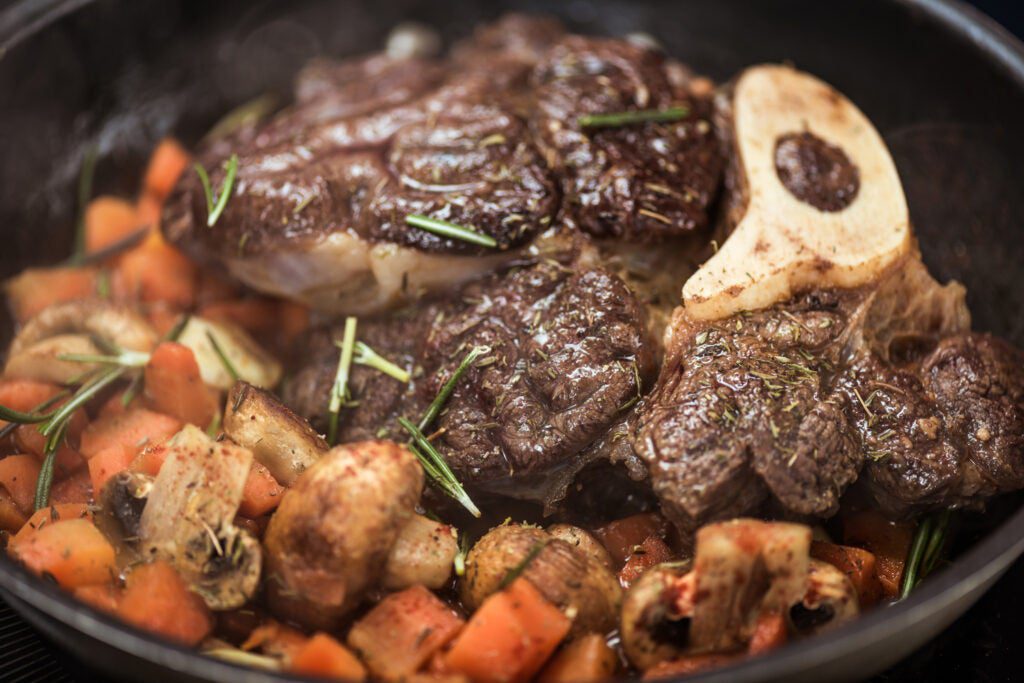Braising is cooking meat or vegetables in a flavorful liquid slowly, creating soft and succulent meat, infused with rich, savory flavor. This technique helps tough, lower-priced cuts of meat break down the tough collagen fibers, providing a one-pot meal with minimal cleanup. Braising also lets you infuse meats with various flavorful ingredients such as spices, wine, and stock, creating a complex taste that can’t be achieved by other cooking methods. To become a braising pro, choose the right meat cut, sear the meat first, add flavorful ingredients such as herbs, wine, stock, and slow-cook the dish for 2-3 hours.
Slow and Steady Wins the Race: The Art of Braising
Braising is a cooking technique that involves cooking meat or vegetables slowly in a flavorful liquid. This results in tender, juicy meat infused with rich, savory flavor. Braising is a great way to transform tough, cheap cuts of meat into delectable dishes that will impress even the most discerning food critic.
The Benefits of Braising
There are several benefits to braising that make it a great technique to master in the kitchen.
Tenderizing Tough Cuts of Meat
Braising is ideal for cuts of meat that are tough, such as brisket, chuck roast, and pork shoulder. These cuts of meat are typically less expensive than more tender cuts, but they require more cooking to break down the tough collagen fibers. Braising provides the perfect environment for tenderization by cooking the meat slowly over a long period of time in a moist environment.
Infusing Flavor
Braising provides an opportunity to infuse your meats with a variety of flavorful ingredients, such as herbs, spices, wine, and stock. The long, slow cooking process allows these flavors to permeate the meat, resulting in a delicious, complex taste that cannot be achieved through other cooking methods.
One-Pot Meal Convenience
Braising is a one-pot meal that requires minimal cleanup. After the initial prep work, you can simply let the meat and vegetables simmer in the braising liquid until they are tender and flavorful. Plus, the leftovers taste even better the next day, making braised dishes a great option for meal prep.
Getting Started with Braising
For beginners, braising can seem intimidating, but it doesn’t have to be. Follow these tips and tricks to become a braising pro in no time.
Choose the Right Cut of Meat
As mentioned earlier, braising is ideal for tough cuts of meat that are less expensive than more tender cuts. Look for cuts labeled as chuck roast, brisket, or pork shoulder, and avoid leaner cuts that will dry out during the long cooking process.
Prep Your Ingredients
Before braising, take the time to prep your ingredients. This includes searing the meat, chopping vegetables, and measuring out any additional ingredients you will need.
Use a Heavy, Oven-Safe Pot
Braising requires a heavy, oven-safe pot with a tight-fitting lid. Cast iron dutch ovens and enameled cast iron pots are great options for braising because they retain heat well and can be used on both the stovetop and in the oven.
Sear the Meat First
Before braising, sear the meat on all sides to develop a brown crust. This will add flavor and help to hold in the juices.
Add Flavorful Ingredients
Once the meat is seared, add aromatics such as onions, garlic, and celery to the pot. Then, pour in your braising liquid, such as stock, wine, or beer. Finally, add any additional seasonings or herbs that will infuse flavor into the dish.
Cover and Cook Low and Slow
Once you’ve added all of your ingredients, cover the pot and cook the dish low and slow in the oven. Generally, you will want to braise for 2-3 hours, but cooking times will vary depending on the cut of meat you are using.
Adjust Seasoning and Serve
After the braising is complete, adjust the seasoning as needed and serve the meat with the flavorful braising liquid and vegetables.
Conclusion
Braising is a versatile and rewarding cooking technique that can transform tough cuts of meat into tender, flavorful dishes. By following the steps outlined above, even beginners can master the art of braising and create impressive meals that will please any palate. So, slow down, take your time, and let the flavors develop as you perfect the art of braising.
